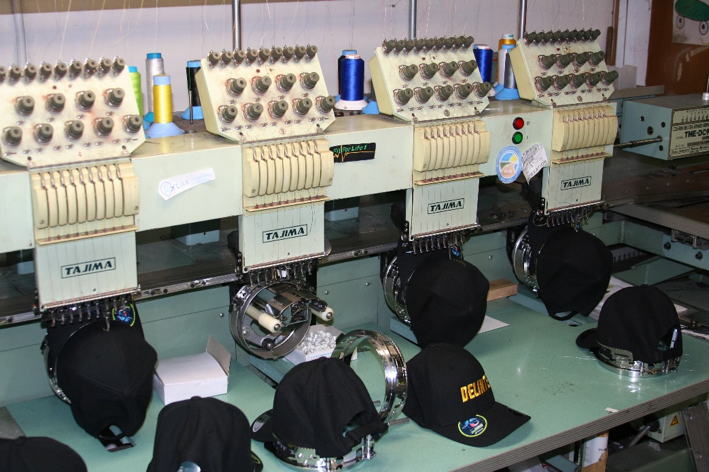

- THE EMBROIDERY PROCESS
- ART REQUIREMENTS: WHAT KIND OF ART IS GOOD FOR EMBROIDERY
- EMBROIDERY TERMS

THE EMBROIDERY PROCESS
There are many very detail driven steps that go into creating a beautifully embroidered garment.
REVIEW ART SUBMISSION
When reviewing the art, we look for fine detail, gradients and small lettering that may not translate well. We’ll be sure to make a recommendation or give you some options if your logo will not embroider well on a garment.
DIGITIZING
Digitizing is the process by which we translate digital art files into stitches. The first part of the process is a virtual drawing that maps the stitches we will use to embroider the final logo. This is done using specialized software.
SEW OUT
Although the digitized file gives us a pretty realistic assessment of what the final embroidery will look like, we prefer to create an actual stitched out sample to be sure. We’ll make any tweaks or adjustments from there and if requested we will send the final sew out to you for your approval.
HOOPING & CLAMPING
An embroidery hoop is a plastic ring that snaps around the area of the garment to be sewn. This hoop is affixed to a head on the embroidery machine. This is called clamping. These steps are taken to stabilize the garment as the needle sews the fabric.
TRIMMING
Once the garments are sewn, we remove the excess backing from the embroidered design. Sometimes a tear-away backing is used, and it can be pulled off. Other times the backing must be cut, or trimmed, from the back of the garment. This step in the process is referred to as trimming no matter which method is used.
STEAMING
The embroidery hoop has a tendency to leave a ring on certain garments. This does not damage the fabric. We simply recommend steaming, or just simply washing these items to return them to their pre-embroidered appearance.
ART REQUIREMENTS: WHAT KIND OF ART IS GOOD FOR EMBROIDERY
All art files are re-drawn as digital stitch files in preparation for embroidery. The best embroidery comes from very clean, high quality digital files. Vector format is preferred.
- Specify fabric type when submitting a logo for embroidery. An embroidered logo may look different when sew on different fabric types. By specifying the fabric type, we can digitize for the best embroidery for that material.
- Submit Adobe Illustrator vector art files for best quality embroidery.
- Smallest letter size can be no smaller than 1/4†tall.
- Thin lettering and small detail does not embroider well on deep pile garments.
EMBROIDERY TERMS
DIGITIZING
Process for converting digital images or logos into a map of stitches. The digitized file is uploaded to the embroidery machine to provide instructions for location of stitches and thread color.
BACKING
Stiff fabric applied to the inside of the garment to keep the embroidery stitches stable through embroidery, wear, and wash. There are 2 main types of backing:
- Tear Away Backing – Tear away is the most common type of backing used. It is the quickest and easiest to remove for the most common types of embroidered garments. Tear away backing is used on the sturdy, strong fabrics such as caps, dress shirts, back packs, etc.
- Cut Away Backing – Cut away is used on softer materials that we embroider. This type of backing eliminates the tendency of a fabric to pull away from the embroidered logo when using tear away. We use cut away backing on knit fabrics such as pique.
SOLVY TOPPING
Solvy is used to create a smooth foundation for embroidering custom designs. It is applied on the top or outside of the garment and is covered by the embroidered design. Not all garments require the use of a topping. Solvy is primarily used on high pile fabrics (fleece, hoodies, towels) to help the stitches stay visible and avoid the embroidered design becoming lost in the fabric.
Have an Embroidery design that needs to go from concept to reality? Get in touch with a Hotspot Printing & Packaging specialist today! You can call us, 310-538-2540, or submit a quote online.
